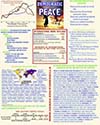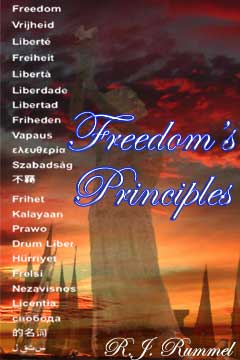[First published June 21, 2005] This post is a chapter on the power principle from my book on Freedom’s Principles. linked in the fight sidebar. If you want a better theoretical understanding of political freedom and conflict, regardless of the level — family, social, national, and international — this chapter you must read. For one, it shows that power is a complex concept encompassing a family of powers that include, of course, authority and coercion, but also love and intellectual power. It illuminates the basic point that there is a world of difference between physical and social powers, and that social powers operate through another’s mental field (know this, and you then understand the essentials of politics). Such power is nothing unless others see and respond to it. Moreover, the chapter begins to lay bare the basic difference between dictatorships and free societies, which is in their basic ordering power — coercion for the former and exchange for the latter. And here begins the all-important understanding of the spontaneous society of a free society, and what makes it function.
Most important, is the power equation. If I could, I would have everyone tattoo this on their shoulder, for it is the basis for understanding all kinds of conflict and peaceful cooperation. Why do couples, groups, and nations go through long periods of cooperation and peace and suddenly break down in conflict? The power equation. How do people who hate each other and nations arrive at a peaceful entente? The power equation. How can a society of free people, without rules or regulation, establish a productive and efficient division of labor? The power equation.
If you get anything out of the chapter on power, it should be that what we do and the social power we have, of whatever kind, is a result of our interests, capability, and will. Yes, will — the underestimated, if too often ignored, spine of politics.
In order to understand how this works, I soon will be writing a chapter for the book blog on the conflict helix, which provides the dynamic linkage of individual power equations. Though it I will show that peace and the spontaneous society (what I call a social field) are the simultaneous solution to individual power equations.
Link of Note
” Getting the hang of this Democracy thing…” (6/8/05) By Major K
Major K says:
This is what progress looks like. It is slow, painful, and usually accompanied by a lot of cigarette smoke, especially in this area of the world, where it seems like everyone smokes. This is the local council of Sheikhs meeting with the local leaders of the Iraqi Police, Iraqi Army and US Forces. There was plenty of arguing about security, the tactics of the Iraqi Army, and the Sheikhs using their influence to root out the arhabi in their neighborhoods and report them to the Iraqi authorities. Our interpreter was struggling to keep up with the number of people speaking. As usual, almost everyone was looking out for themselves, but the key was this. No one got shot, stabbed, slapped, punched or thrown out a window. In fact, they Iraqi leaders of the meeting admonished everyone to watch their tone and be respectful toward each other in spite of their disagreements. Just like meetings back in America, much more was said than was actually accomplished, but the fact the these folks are getting together without being at gunpoint is another sign that we’re moving in the right direction. They all walked away, and will live to meet again next week.
Colleague comments:
Here is a great real world contemporary example of “Democracy is a Method of Non-Violence” — from a Blog by a military guy in Iraq – -who is showing more sophistication and “realism” than any dozen professors of political science . . . . THIS blog entry is what “power to the people” and “democracy” and “freedom” are all about — not all the crap dissertated upon by totalitarians in disguise!



 Posted by rudyrummel
Posted by rudyrummel 






